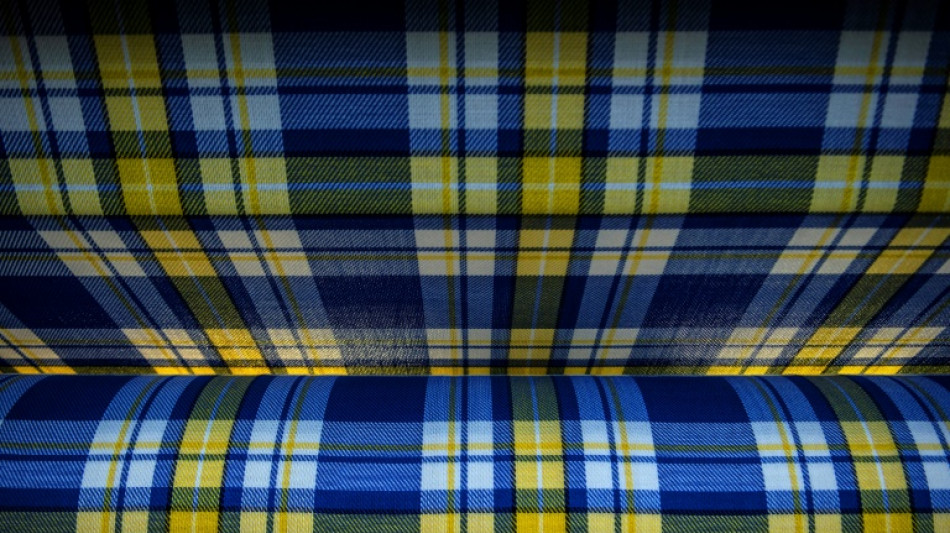
| CMSC | -0.24% | 24.55 | $ | |
| SCS | -0.75% | 13.27 | $ | |
| RIO | -0.31% | 60.43 | $ | |
| BCC | -1.57% | 140.35 | $ | |
| JRI | -0.23% | 13.21 | $ | |
| RBGPF | 100% | 61.84 | $ | |
| NGG | 0.4% | 62.37 | $ | |
| CMSD | -0.02% | 24.725 | $ | |
| BCE | -1.38% | 26.84 | $ | |
| RYCEF | -4.71% | 6.79 | $ | |
| BP | 1.65% | 29.05 | $ | |
| RELX | -0.37% | 45.95 | $ | |
| GSK | -2.09% | 34.39 | $ | |
| AZN | -0.38% | 65.04 | $ | |
| VOD | -0.81% | 8.68 | $ | |
| BTI | 0.2% | 35.49 | $ |

Ukrainian tartan proves a hit in Scotland
At a tartan workshop in northeast Scotland, machines slowly unwind miles of the familiar criss-cross patterns of fabric in green, red, black, blue and white.
But one chequered design at the Macnaughton Holdings' giant factory in Keith stands out for its unconventional colours: yellow and royal blue.
For a few weeks now, the Great Scot company, a client of the firm, has been weaving its "Ukraine Forever Tartan", to raise funds for victims of the war.
"We saw what was happening on the news and like so many people we were appalled," said Patrick Lewtas, Great Scot's head of operations.
"We thought, what can we do? We could do something to raise some money and give to charities. Let's design a tartan," he told AFP.
"We've had an amazing response from this from all over the world."
The tartan design refers to the pattern of interlocking stripes of two or more colours running horizontally and vertically through the cloth.
It is Scotland's national fabric and different colours, particularly on kilts, have long been identified with Scottish regions and Highland clans.
Once banned in the 18th century, the design has since been popularised both as a political and a fashion statement, in Scotland and around the world.
When the Ukrainian tartan was first unveiled on Great Scot's Facebook page, it was shared 10,000 times, got nearly 140,000 likes and more than 2,700 comments.
Ukraine's foreign ministry also praised the initiative on its Twitter account.
- Proud history -
More than two miles (3.2 kilometres) of the fabric have already been sold, with strong demand from the United States, as well as Ukrainian expatriates.
The design is now included on the Scottish Register of Tartans, and each sale sees a donation to the UK Disasters Emergency Committee's Ukraine Humanitarian Appeal.
"Ultimately we'd like to raise more than £40,000 or £50,000 ($50,000-$63,000, 48,000-59,000 euros)," said Great Scot founder Margo Page, wearing a belted red tartan jacket.
"We're not there yet but people keep asking us to weave."
To those who accuse her of profiting from the war to boost sales, Page says she has chosen independent, family-run factories to produce the tartan.
"We could profit from many, many things. The whole basis of Great Scot is all about putting cloth to work in UK family-owned artisanal mills," she said.
"It's about keeping those traditions going."
She added: "We're not the most commercially viable by choosing those traditional mills. Our balance sheet proves we didn't profit from this tartan."
Creating a Ukrainian tartan has not been without financial risk: money has had to be advanced for yarns, dyes and production.
Now Page says her dream is to "put a kilt on (Volodymyr) Zelensky", Ukraine's president.
Euan Dalgliesh, assistant manager in the Keith factory, said: "We're proud of weaving our national fabric.
"If it helps other people it's great. We're always surprised by the demand for tartan. Generation after generation, we've been weaving tartan.
"But you think you're always at the peak but demand continues and continues.
"We're proud of our history and Ukrainians are proud of their history."
J.Goergen--LiLuX



